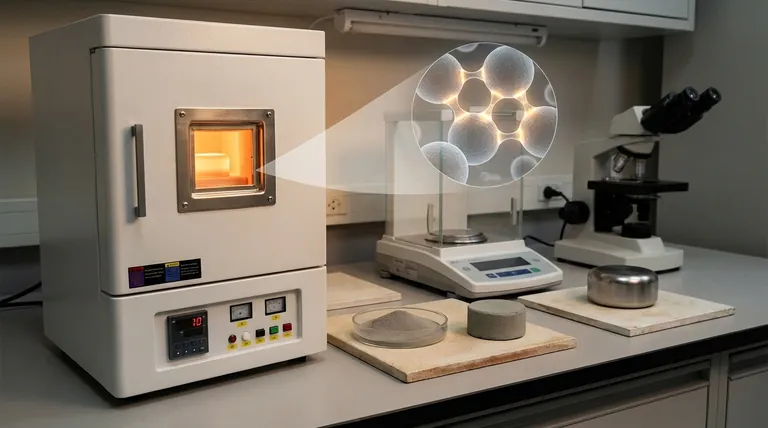In short, sintering increases strength by using heat to fuse individual particles into a solid mass without melting them. This process eliminates the voids between the particles, creating strong metallurgical bonds and forming a dense, continuous structure that can effectively withstand and distribute mechanical stress.
Sintering is not about melting a material into shape. Instead, it is a carefully controlled thermal process that gives atoms just enough energy to move and bond across particle boundaries, transforming a weak powder compact into a strong, dense, engineering material.

The Fundamental Mechanism: From Powder to Solid
To understand how sintering imparts strength, we must look at the microscopic changes it induces in a material. The process begins with a collection of individual particles, often pressed into a desired shape (a "green body"), which has very little structural integrity.
The Role of Atomic Diffusion
At elevated temperatures—well below the material's melting point—the atoms within the particles gain significant thermal energy. This energy allows them to move, or diffuse, from an area of high concentration to an area of low concentration. This is the same fundamental process that occurs naturally over geological time, fusing mineral particles into high-density ore.
Neck Formation and Growth
The process begins where particles touch. Atoms migrate to these points of contact, forming small bridges or "necks." As more atoms diffuse to these areas, the necks grow wider and stronger, effectively welding the particles together with powerful metallurgical bonds.
Pore Elimination and Densification
The initial powder compact is full of empty spaces, or pores. As the necks between particles grow, these pores shrink and are gradually eliminated. The material becomes denser. Eliminating this porosity is the primary source of increased strength, as pores act as internal defects where cracks can easily start under stress.
Why This Transformation Creates Strength
A loose collection of powder has virtually no strength because the particles are not bonded. Sintering fundamentally changes this by creating a unified, solid structure.
Eliminating Inherent Weak Points
The voids in an unsintered part are significant weak points. When a force is applied, the stress becomes highly concentrated at the tiny contact points between particles, leading to immediate failure. By creating a dense, continuous structure, sintering allows that force to be distributed evenly across the entire material.
Creating a Continuous Crystalline Structure
Sintering transforms a mechanical assembly of individual grains into a single, polycrystalline solid. Force is no longer transferred through fragile physical contact points but through a continuous network of strong atomic bonds. This is the difference between a pile of sand and a solid piece of sandstone.
Understanding the Trade-offs and Common Pitfalls
While powerful, sintering is a delicate process that requires precise control. Without it, the final part's strength and integrity can be compromised.
The Risk of Warping and Sagging
Although the material is not molten, it is in a softened state at sintering temperatures. Because of this, parts can deform under their own weight (sagging) or due to friction with the surface they rest on. This can compromise the final dimensions and introduce internal stresses.
Incomplete Sintering
If the temperature is too low or the time is too short, the process of necking and densification will be incomplete. The resulting part will retain a high degree of porosity, making it significantly weaker and more brittle than a fully sintered component.
Excessive Grain Growth
Conversely, sintering at too high a temperature or for too long can cause the individual crystals (grains) within the material to grow too large. While the material may be dense, excessively large grains can sometimes reduce toughness and make the material more susceptible to fracture.
How to Apply This to Your Project
Your specific goals for the final component will determine how you approach the sintering process.
- If your primary focus is maximum strength and density: You must optimize for complete pore elimination by carefully controlling temperature, time, and potentially using pressure (as in hot-press sintering) to drive particles together.
- If your primary focus is high dimensional accuracy: You must design support structures and manage thermal cycles carefully to mitigate the risks of warping and sagging during the high-temperature phase.
- If your primary focus is balancing strength with other properties (like toughness): You need to control grain growth by avoiding excessive time at peak temperature, achieving a fine-grained, dense final structure.
By mastering this thermal process, you are fundamentally controlling atomic movement to build superior macroscopic strength.
Summary Table:
| Key Sintering Effect | Impact on Strength |
|---|---|
| Neck Formation | Creates strong metallurgical bonds between particles. |
| Pore Elimination | Removes internal weak points where cracks can start. |
| Densification | Forms a continuous structure to evenly distribute stress. |
| Grain Bonding | Transforms powder into a unified polycrystalline solid. |
Ready to enhance your materials' strength with precision sintering? KINTEK specializes in lab equipment and consumables for advanced thermal processing. Our expertise helps you achieve optimal density and mechanical properties for your laboratory needs. Contact our experts today to discuss your project!
Visual Guide

Related Products
- 1800℃ Muffle Oven Furnace for Laboratory
- 1700℃ Muffle Oven Furnace for Laboratory
- Laboratory Muffle Oven Furnace Bottom Lifting Muffle Furnace
- 1400℃ Muffle Oven Furnace for Laboratory
- High Temperature Muffle Oven Furnace for Laboratory Debinding and Pre Sintering
People Also Ask
- What are the disadvantages of a muffle furnace? Understanding the Trade-offs for Your Lab
- What is done by ashing in muffle furnace? A Guide to Precise Inorganic Content Analysis
- What is the difference between muffle furnace and air oven? Choose the Right Tool for Your Thermal Process
- What are the different types of laboratory furnaces? Find the Perfect Fit for Your Application
- What is a laboratory furnace called? A Guide to Muffle and Tube Furnaces



















